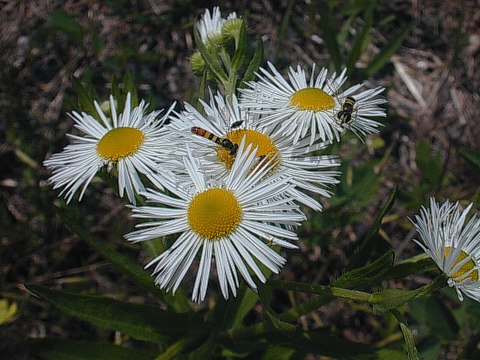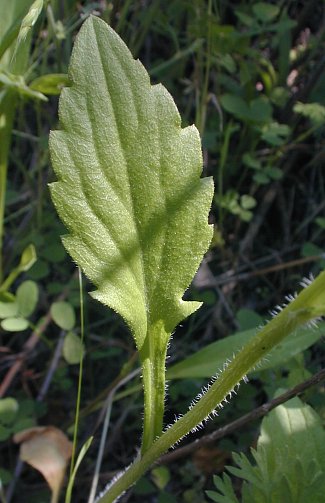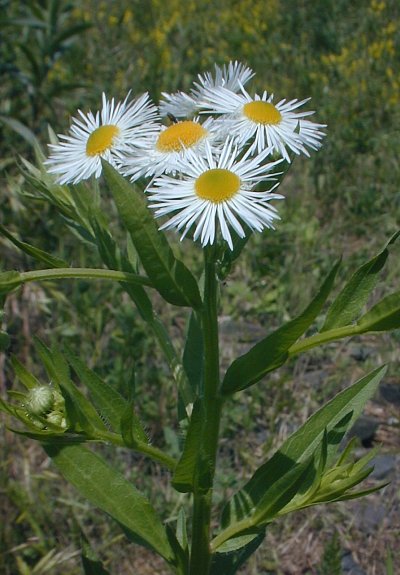Description: This is an annual or biennial plant that is up to 3½' tall, branching occasionally in the upper half to form flowering stems. The central stem has spreading white hairs throughout its length. The leaves toward the base are 3-5" long with sizable petioles, and they are lanceolate, ovate, or oblanceolate in shape. The leaves along the upper stems are smaller in size, without petioles, and usually lanceolate. These alternate leaves are rather common along the stems, even toward the top of the plant. The lower leaves are often coarsely serrated or dentate, while the upper leaves may have a few coarse teeth toward their outer tips. Small clusters of daisy-like composite flowers occur toward the apex of the plant, each about ½–¾" across. The central disk florets are numerous, very small, and yellow; they are surrounded by 50-120 white ray florets. Both kinds of florets can be self-fertile. The flower buds often have conspicuous white hairs. The blooming period begins in early summer and continues intermittently until the fall, usually with a lull during the hot weather of late summer. A mild fragrance is sometimes detectable. The root system is fibrous and spreading. The achenes have tufts of small hairs (which they sometimes lose); they are distributed by the wind.

Cultivation:
The preference is full or partial sun, and moist to mesic conditions.
This plant isn't fussy about soil characteristics, and tolerates clay
or gravel to a greater extent than many others. It's easy to grow, but
can spread aggressively by re-seeding itself in disturbed areas.
Sometimes the lower leaves will turn yellow and wither away during hot
dry weather. The size of Annual Fleabane can vary considerably
depending upon soil fertility, moisture amounts, and competition from
neighboring plants.
Range & Habitat:
The native Annual Fleabane is very common, and it has been reported in
every county of Illinois (see Distribution
Map). Typical habitats include disturbed areas of moist to
slightly dry prairies, pastures and abandoned fields, areas along
roadsides and railroads, disturbed open woods, and various kinds of
waste areas. This is a native pioneer species that competes directly
with many Eurasian weeds.

Faunal Associations: The nectar and pollen of the flowerheads attract a variety of insects, including Halictid bees, masked bees (Hylaeus spp.), Sphecid wasps, Vespid wasps, Syrphid flies, soldier flies (Stratiomyidae), blow flies (Lucilia spp.), Tachinid flies, flesh flies (Sarcophagidae), plant bugs, and miscellaneous beetles (Robertson, 1929; Graenicher, 1909). Various insects feed on the foliage, roots, and other parts of Annual Fleabane. These species include a leaf beetle (Calligrapha praecelsis), larvae of a gall fly (Asteromyia modesta), Tarnished Plant Bug (Lygus lineolaris), Red-spotted Aster Mirid (Polymerus basalis), Broken-backed Bug (Taylorilygus apicalis), some aphids (Uroleucon erigeronense, Uroleucon gravicorne, Prociphilus erigeronensis), and larvae of the Lynx Flower Moth (Schinia lynx); see Clark et al. (2004), Stireman et al. (2010), Snodgrass et al. (1984), Pepper (1965), Blackman & Eastop (2013), and Covell (1984/2005). Some mammalian herbivores have been observed eating the foliage of fleabanes, including sheep and deer (Georgia, 1913; Noble Foundation, 2007). The wild House Mouse and White-footed Mouse also eat the seeds (Whitaker, 1966).

Photographic
Location:
The photographs were taken along an abandoned railroad in
Urbana, Illinois.
Comments:
This is a pretty, but ubiquitous plant that will appear on its own
without any official encouragement. It can be distinguished from asters
with similar flowers by its earlier blooming season and more numerous
ray florets. Annual Fleabane differs from Erigeron strigosus
(Daisy Fleabane) by its more numerous and broader leaves, and the long
spreading white hairs that occur along the entire length of its stems.
Daisy Fleabane, on the other hand, has more slender leaves and short
appressed hairs that occur along the middle and upper portions of the
stems. A similar species, Erigeron
philadelphicus (Marsh Fleabane), has leaves that clasp the
stems and its flowerheads have more ray and disk florets than Annual
Fleabane.